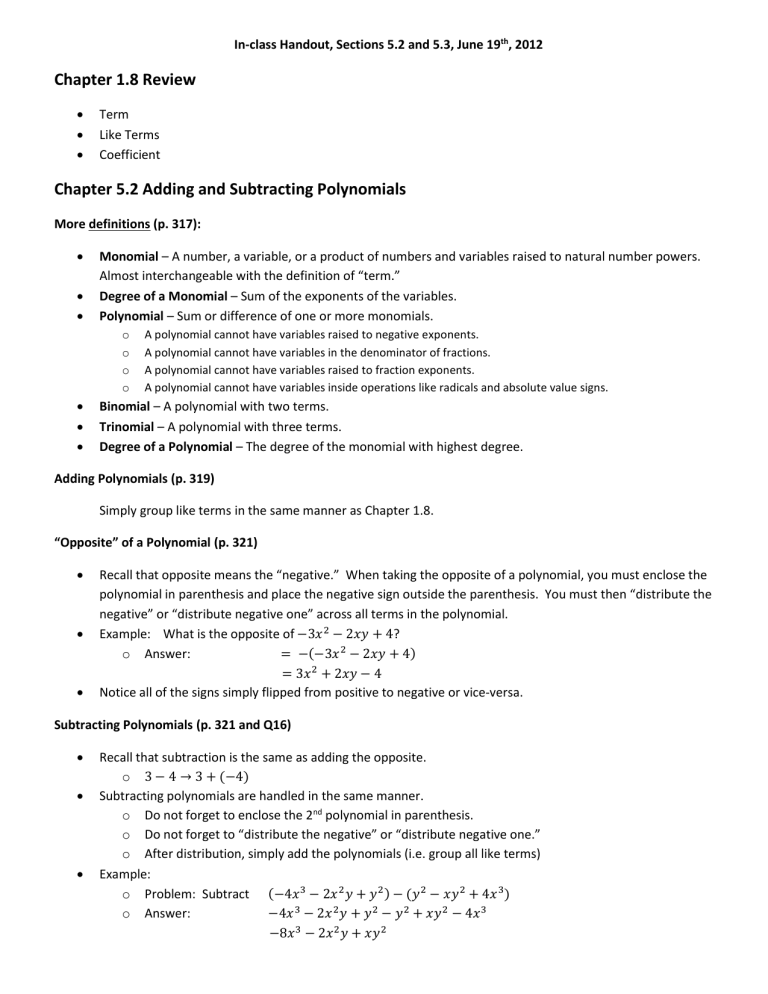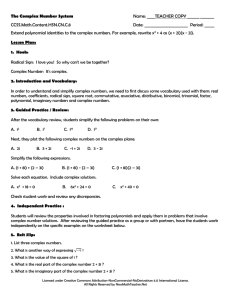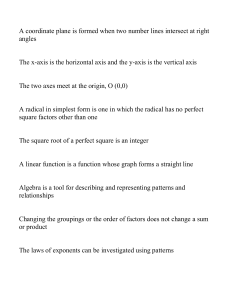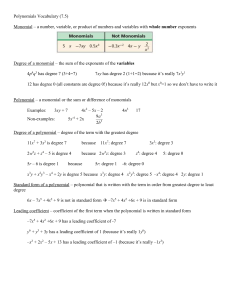Chapter 5.3 Multiplying Polynomials

In-class Handout, Sections 5.2 and 5.3, June 19 th , 2012
Chapter 1.8 Review
Term
Like Terms
Coefficient
Chapter 5.2 Adding and Subtracting Polynomials
More definitions (p. 317):
Monomial – A number, a variable, or a product of numbers and variables raised to natural number powers.
Almost interchangeable with the definition of “term.”
Degree of a Monomial – Sum of the exponents of the variables.
Polynomial – Sum or difference of one or more monomials. o A polynomial cannot have variables raised to negative exponents. o A polynomial cannot have variables in the denominator of fractions. o A polynomial cannot have variables raised to fraction exponents. o A polynomial cannot have variables inside operations like radicals and absolute value signs.
Binomial – A polynomial with two terms.
Trinomial – A polynomial with three terms.
Degree of a Polynomial – The degree of the monomial with highest degree.
Adding Polynomials (p. 319)
Simply group like terms in the same manner as Chapter 1.8.
“Opposite” of a Polynomial (p. 321)
Recall that opposite means the “negative.” When taking the opposite of a polynomial, you must enclose the polynomial in parenthesis and place the negative sign outside the parenthesis. You must then “distribute the negative” or “distribute negative one” across all terms in the polynomial.
Example: What is the opposite of −3𝑥
2
− 2𝑥𝑦 + 4 ? o Answer: = −(−3𝑥 2 − 2𝑥𝑦 + 4)
= 3𝑥
2
+ 2𝑥𝑦 − 4
Notice all of the signs simply flipped from positive to negative or vice-versa.
Subtracting Polynomials (p. 321 and Q16)
Recall that subtraction is the same as adding the opposite. o 3 − 4 → 3 + (−4)
Subtracting polynomials are handled in the same manner. o Do not forget to enclose the 2 nd polynomial in parenthesis. o Do not forget to “distribute the negative” or “distribute negative one.” o After distribution, simply add the polynomials (i.e. group all like terms)
Example: o Problem: Subtract (−4𝑥 3 o Answer: −4𝑥
3
− 2𝑥 2 𝑦 + 𝑦
− 2𝑥
2 𝑦 + 𝑦
2
2 ) − (𝑦
− 𝑦
2
2 − 𝑥𝑦
+ 𝑥𝑦
2
2 + 4𝑥
− 4𝑥
3
3 )
−8𝑥
3
− 2𝑥
2 𝑦 + 𝑥𝑦
2
Chapter 5.3 Multiplying Polynomials
Monomial x Monomial (p. 328)
When multiplying monomials the only operations we dealing with are multiplication and exponents. Using the commutative and associative properties of multiplication we can re-order the coefficients and variables together in any order. Finally, when multiplying variables raised to exponents, take advantage of the product
rule for exponents (add the exponents).
Example: o Problem: Simplify −7𝑥
3 𝑦𝑧
5
∙ −2𝑥𝑦
4 o Answer: (−7 ∙ −2) ∙ (𝑥 3 𝑥) ∙ (𝑦𝑦 4 ) ∙ 𝑧 5
14𝑥
4 𝑦
5 𝑧
5
(usually skip this step)
Monomial x Polynomial (p. 329 and Q17)
When multiplying a monomial by a polynomial, distribute the monomial across all terms in the polynomial.
Example: o Problem: Simplify −𝑥𝑦
3
(−𝑥
2
+ 𝑥 + 4) o Answer: (−𝑥𝑦 3 )(−𝑥 2 ) + (−𝑥𝑦 3 )(𝑥) + (−𝑥𝑦 3 )(4) (usually skip this step) 𝑥
3 𝑦
3
− 𝑥
2 𝑦
3
− 4𝑥𝑦
3
Binomial x Binomial (using distribution) (p. 330 and Q18)
Multiply: (2𝑥 − 5𝑦)(𝑥 + 2𝑦) o Distribute 2𝑥 across (𝑥 + 2𝑦) o Distribute (−5𝑦) across (𝑥 + 2𝑦) o Add all the resulting terms, grouping any like terms
Visually, Multiply:
(2𝑥 − 5𝑦)(𝑥 + 2𝑦)
(2𝑥)(𝑥 + 2𝑦) + (−5𝑦)(𝑥 + 2𝑦)
2𝑥
2
+ 4𝑥𝑦 − 5𝑥𝑦 − 10𝑦
2
2𝑥 2 − 𝑥𝑦 − 10𝑦 2
This method applies to the more general Polynomial x Polynomial problem
Binomial x Binomial (using FOIL) (p. 330 and Q18)
FOIL is a mnemonic (First, Outer, Inner, Last) or (First, Outside, Inside, Last)
Multiply: (𝑥 − 4𝑦)(4𝑥 − 5𝑦)
F O I L
4𝑥
2
− 5𝑥𝑦 − 16𝑥𝑦 + 20𝑦
2
First
4𝑥
2
− 21𝑥𝑦 + 20𝑦
2
Last
(𝑥 − 4𝑦)(4𝑥 − 5𝑦)
This mnemonic only applies when multiplying two binomials.
Outer
Inner






